
Protective Shoeing,
What it is, and how it can protect your horse from lameness
by Graeme Burt, D.W.C.F, farrier.
Horn constantly grows downwards, from the coronary band at the top to the ground, where it is destroyed. As it grows, it expands, the bottom of the foot being wider than the top, and this means that as it grows, fresh horn is secreted from within, to allow the horn to expand.
The growth is intended to be at a similar rate to the destruction, which is what keeps the horse sound. Thats the theory, but in fact both growth of horn and its destruction happen at different rates, depending on the environment the horse is living in, the work he does, the food he is eating, the time of year, and the quality of the horn that is produced, which is largely a genetic factor.
Many people think horses feet that break up and disintegrate in warm weather do so because they are drying out, indeed I used to think the same. But there is a considerable hole in this argument. That is, if drying out is the problem, how come horses that live in warm dry climates, such as Spain, or Arizona, or Arabia, rarely ever need shoes at all? Their feet are almost invariably rock hard and incredibly tough, but if lack of moisture causes breakup, they should be the very worst affected by this process. Clearly this is not the case, and there is something far more complex going on.
This study has revealed that in fact, horses feet in Britain are very high in moisture in the area where hoof destruction occurs. That moisture is trapped by capillary action at the base of the hoof between the shoe and the foot when the horse has shoes on in our wet climate, and it causes an explosion in the population of bacteria which use this moisture within the wall to multiply exponentially, undermine and destroy the underlying structure, causing weakening, collapse, and eventual breakup. To see why this happens, we need to look at what happens with wild horses.
It is true that horses feet contain, and actually need, a certain level of moisture in the horn, to maintain it's flexibility, and ability to spring back into shape. The moisture the horn requires to do this is however regulated from within the foot. It does not come from an external source, indeed, in wild conditions, there may be very little external moisture present anyway, but still moisture levels in the horn are maintained.
Wild horses evolved on dry plains grasslands, such as that inhabited by modern African Zebra, to whom they are closely related on the Equine genetic tree.
Plains have quite lengthy dry periods followed by a rainy season. During periods of rain when food and grass is plentiful, wild horses do not need to move about much to find rich grazing, and so do not wear their feet down as much; as a result their feet become long, which is a potential risk to their ability to flee a predator, so another method of destruction of the excess horn is employed.
We have all seen the enthusiasm of the dogs in the yards in which we shoe to eat up the horn in as large a quantity as they can. This is because the horn is in fact packed with locked up vitamins and proteins that the dog's remarkable digestive system is capable of absorbing; but what is less well known is that dogs are not the only creatures who can digest this valuable resource. A selection of many of the world's scavengers can also digest horn, rats, cats, foxes, even chickens can do so. And there are other more plentiful creatures that can do it, I speak of bacteria, some of which are highly specialised in the breaking down and consuming of the horn.
I believe there are specialist bacteria that eat horn, also that they are reasonably plentiful and commonplace. I do not speak of the Onicomycosis bacterium; this bug is constantly referred to by farriers in reference to horn damage, but in humans, although it causes nails to grow incorrectly, it does not damage the already present nail. This means it acts on the producing surface, not what has already been produced. It may well be a factor in certain hoof conditions such as canker, where the horn production is damaged, but my belief is that there are other far more common bacteria that consume the nutrients present in keratin, the main constituent in the horn.
Scientists working in other fields of keratin destruction have discovered that a very common bacterium called Bacillus Subtilis has a strain that can catalyse enzymes to attacking and breaking down keratin molecules, indeed they have been specially breeding them to do so, as there are waste materials such as chicken feathers which are another form of keratin that can be broken down in this way to provide plant meal.
This is not necessarily the method horses employ, not enough research is done yet in this field to be sure whether this particular bacterium is the culprit, but I would suggest it is a very likely candidate. It is extremely common, especially in an Equine environment, as it actually exists within the stomachs of horses where it actually does a considerable amount of good work controlling harmful bacteria; it is also quite hardy, requiring relatively caustic conditions to kill it.
This means these bacterium can be killed, but easily return and multiply very rapidly, in a matter of hours, because their lifecycles are very short, and they exist very close to their host.
A lot of farriers will talk about 'flaky' or 'crumbly' horn - indeed horseowners also often see this when picking out the feet.
It is often remarked upon, as it can often smell quite unpleasant. It is prevalent during or slightly following wet and warm periods.
It is especially noticeable when horses are being shod, the farrier will run his knife around the sole, and it will crumble away, revealing a freshly grown sole beneath.
But how did the horn become crumbly? It certainly did not start out that way.
The crumbly and flaky horn that we see is actually what is left of the horn when a combination of moisture, bacteria and warmth have combined to rid the horn of its cohesion, or its ability to stay intact. Bacteria have then consumed all the nutrients and left crumbly waste matter behind. That is why it smells so bad - the resulting debris is literally rotting, and full of active bacteria and their waste products. Yuk!
Likewise, the frog also can become infected and undermined with a common infection we call thrush, which also causes the horn of the frog to disintegrate and smell bad.
What is less well known is that this rotting, or lack of cohesion, doesnt just affect the soles and frogs of the foot. It also gets into the hoof wall, but it does so in a specific way, and the reason for this is because it is part of the naturally destructive process that wild horses employ, and have employed throughout the horse's long evolution.
I believe horses have for many thousands of years enjoyed a symbiotic relationship with bacteria that weaken and finally destroy the excess horn to shorten their feet during rainy seasons when food is plentiful; the bacteria eat away from the inside border of the lower wall at the white line, and weaken the base of the wall until it breaks off, not all in one piece as humans would do it, but in chunks which leaves some horn still present to bear the horses weight.
Bacteria enter the feet with moisture from the underside of the foot. This process generally accelerates if it follows a protracted period of wet conditions such as a British winter. The horn at the base of the inner wall has open tubules, which are like microscopic drinking straws, open at the bottom, especially at its inside border with the white line - after a period of considerable rain, the tubules gradually absorb the moisture from their surroundings under capillary action, like a sponge drawing the moisture in.
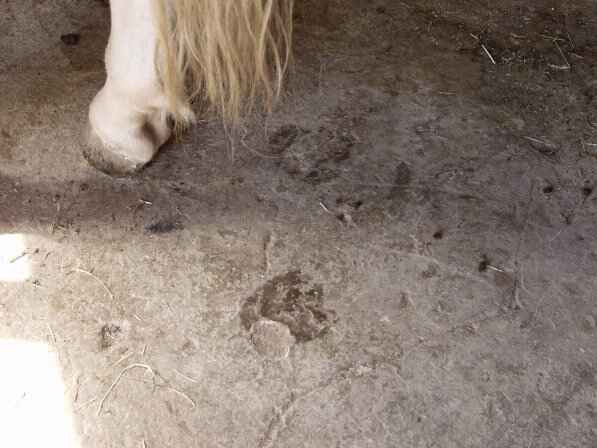 |
You
can see from this photo that this horse's feet have absorbed lots of
moisture - having taken the shoes off and trimmed this pony's feet, and
the
floor in this barn being very cold, the moisture evaporating from the
feet instantly condensed on the ground, creating moist hoofprints on
the concrete as she moved about. The pony had not stepped in any puddles or wet that day, as you can see by the dry foot. Indeed it was a dry day. By removing the shoes, cleaning and trimming the feet, and keeping the floor swept, clean and dry, and by hot fitting the shoes, I have encouraged air to circulate, and as much of the moisture to evaporate as I can, before the new shoes are applied. This dries and hardens the horn making it tougher and less prone to infection or deformation. |
Moisture at first affects the base of the wall, but as time goes on, the open tubules draw it ever upwards into the inner wall, and it also entering the sole, but the moisture does not come through the wall directly from outside due to the hard compressed nature of the outer wall, until or unless that layer becomes damaged.
The moisture draws in with it the bacteria which consume nutrients in the inner part of the wall once the conditions are right, but the moisture also has a detrimental effect of it's own; it renders the wall much more pliable than it was before, also rids the horn of it's elastic ability to spring back into its proper shape. Consequently, during protracted wet periods, the wall begins to bend upwards and outwards away from the ground pressure caused by the horse's weight (as the horse's weight pushes down, under Newton's law, the ground pushes up with equal force).
Gradually, 'wings' appear on the feet, and the toe begins to stretch forwards, starting at the base where the moisture levels are higher and the horn is softer and weaker, making distortion easier.
As the weaker damaged horn can no longer bear ground pressure, it turns further upwards to avoid it. At this point, the stretching of the outer layer of the outside wall can become intolerable, and it may well start to split, which will allow yet more moisture and bacteria to enter, and allow stretching and bending to accelerate further.
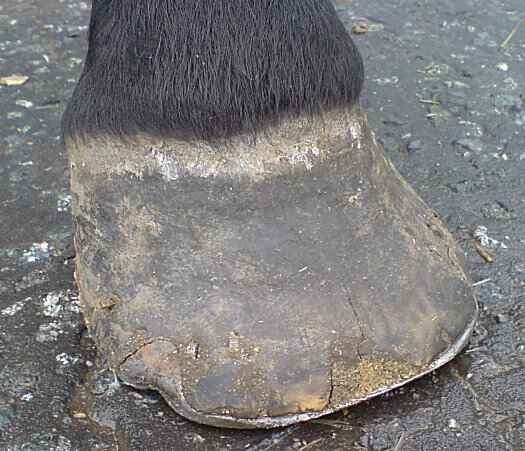 "Wings" and stretched toe |
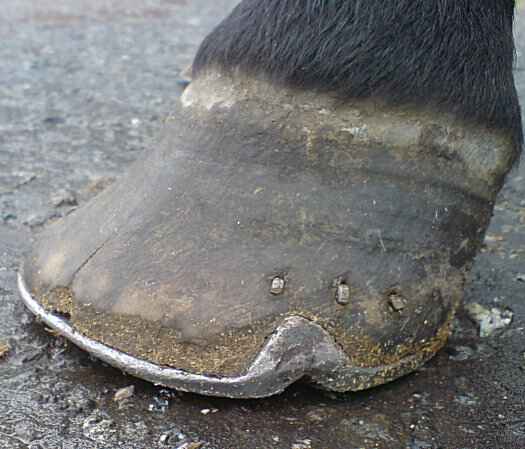 Bending up of the wall at the base is easily seen here. |
Starting gradually from the base of the wall, the entry of further moisture and bacteria has the effect of stretching and tearing the white line in an outward and upward direction around the foot, which means bacteria can enter underneath the torn wall even more easily. Stresses on the stretching horn, bacterial damage and compression tears at the tubules leaving fractures underneath - we often call them seperations.
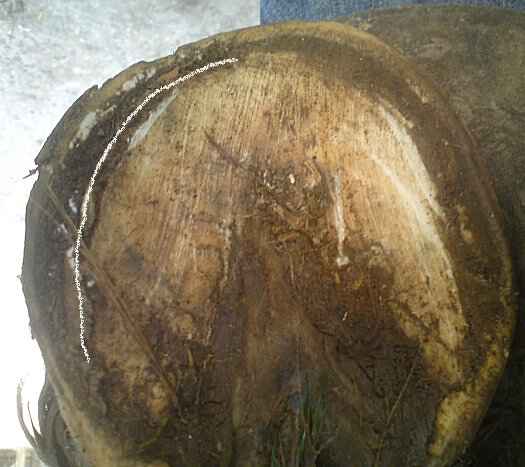 Seperation on this foot. I have emphasised the outer border of the sole with the white mark. You can see how the wall has seperated from the sole with outward stress, leaving a space which is becoming full of debris and mud, including some clearly visible small stones. |
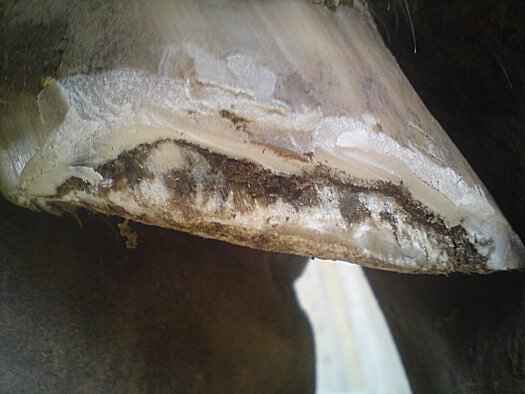 Here you see the same foot, after removal of the outside wall above the seperation. Notice how far up the wall the infection has travelled, denoted by the mud and debris that has got in afterwards. In the wild, this section would have eventually broken off of its own accord, but had this horse had shoes on, an infection like this could easily cause lameness, as this is quite close to the sensitive structures, and the moisture beneath shoes would have encouraged it to go further. |
As you can see, these seperations fill with wet mud, grit and debris, allowing more bacteria and moisture to enter, and the bacteria proceed further up the inside of the wall, undermining it, and gradually eating outwards through it, until the outer excess wall finally weakens, and breaks off. In wild conditions, when a piece breaks off, it exposes the damage underneath to air circulation, which dries it. As a consequence, bacteria levels drop in the area, and the horn hardens, leaving it to grow again, at which time the process repeats over again.
That is how wild horses shorten their feet when they do not need to move around very much.
I speak of horses who live in the wild, but as we domesticate horses the action of these normally favourable bacteria or the moisture damage does not go away, nor do the reasons or position of their ingress. It does become a problem to domestic horses however, and for two main reasons.
Firstly, we artificially trim the feet, this means that the bacterial action far from starting at the outer reaches of the excess wall, starts much closer to the sensitive structures and as a result can penetrate into them much more easily.
Secondly, and probably more importantly, we put shoes on the feet. In our arrogance we do not realise this creates a micro environment beneath those shoes that can destroy a lot of the positive aspects shoes can deliver, as it actually encourages moisture to enter, causing much faster destruction and infection of the horn the shoe is attached to.
Never forget, growth comes from the top downwards, but destruction comes from the base and works its way upwards. The horses feet will only stay healthy if there is more horn being produced than is being damaged and destroyed, and even the very best quality feet can be damaged if the environment favours the mulitplication of bacteria, such as the wet and warm conditions of Springtime and Autumn, or the dewy moist grass present at night in Summer when horses are commonly left out overnight.
It also has to be remembered that moisture itself also damages the horn, causing it to soften, buckle, twist, stretch and lose its ability to spring back into shape. This activity can commonly be seen on horses that are on overnight turnout in the Summer, as the dew appears every night - one acre of good Summer grass can easily have thousands of litres of water attached to it! With each step the horse takes, the foot is 'painted' with water constantly, night after night, weakening the base of the foot, and when daytime temperatures warm everything including the feet, the bacteria levels multiply enormously.
| I have sharpened this
image a little so
that you can clearly see all the droplets of dew attached to the grass.
Like a wet paint brush, the horses feet are 'painted' with moisture
night after night when they are out in summer, which will constantly be
drawn in to the shoe area if not protected. Staggering fact, one acre of dewy grass can contain up to 5000 gallons of water! When you see the amount of water droplets in this picture, it is not so hard to believe. |
There are a number of products that claim to kill horn eating bacteria, and they can be killed, but there are no products that are effectively active for more than twenty four hours or so, and many are active for a far shorter time, such as the commonly used Hydrogen Peroxide.
Horn eating bacteria are commonplace, and will easily return once the effectiveness of any product has faded, or their numbers will simply overwhelm the capacity of any product if conditions favour their multiplication, as their lifecycle is measured in minutes. They can multiply into millions in a few hours. They can also penetrate much more deeply into the horn than a lot of the products that are designed to kill them.
It is my opinion that for these reasons, simply applying a product to the feet, or even into the nail holes, is largely ineffective as a long term solution.
With the mating surfaces of the shoe and foot close together, moisture is drawn into the space between them by capillary action. The shoe also covers the area that the open horn tubules occupy, which are open at the base of the inner wall, remember these are like tiny drinking straws, open at the base. The tubules rapidly draw the moisture and bacteria into the area underneath the wall adjacent to the white line using the same capillary action.
With the nutrients in the horn, the endless supply of moisture weakening and stretching the horn, and the warmth of the sun, the bacteria multiply quickly, and penetrate much further into the underwall than intended, drawing mud and debris behind them. Nail holes help to draw them in as well. If the horse has only recently been shod, such activity gets very close to the sensitive structures, and can penetrate them with relative ease.
Horses in this condition often exhibit discomfort shortly after being shod as moist, infected, black necrotic areas sit against the sensitive laminae, the border of the foot which can be felt by the horse. In white feet, this activity can often be seen by the discolouration and blackening of the horn at the base of the foot beneath the nails. I can equate this with mild toothache in humans; its uncomfortable, and although you can still work with it, it saps your concentration. It is in my opinion one of the most common reasons why veterinary surgeons are called in, but it is rarely identified as a cause of the problem.
Unlike human teeth, however, horse's feet continuously grow, which means that in a horse, the sensitive area can gradually become re-covered with fresh horn, causing the mystery lameness to disappear or become intermittent. Sometimes, relatively infrequently, abscesses form.
It is very important that we have a lasting solution to the problem of hoof destruction, and to do so, I have looked at controlling the factors that cause the bacteria to multiply and moisture to enter the feet and be retained, especially on horses that have shoes on. In other words, instead of killing the bacteria, make the environment unfriendly to them.
That means the horn will grow at a faster rate than the bacteria can damage it, which keeps those all important sensitive areas covered up.
We must remember that bacteria need three things in order to live, multiply and flourish, they are moisture, nutrition, and warmth. If moisture and nutrition are already present in a shod foot, with the advent of warm conditions like a sunny day, the foot warms up and bacteria flourish.
We need to prevent this situation from arising or the horse will not work with confidence, and the only way to prevent it is by taking control of it. That means we need to control at least one of the three factors encouraging the multiplication of the bacteria, their nutrition, the warmth, or the moisture.
We cannot control the nutrition - it is locked up within the structure of the horn, and is what gives the horses foot its strength and flexibility.
We only have limited capacity to control the warmth. Cold winter conditions do slow bacterial damage, but this is when horses are brought into nice warm stables, raising the temperature around the feet, and the blood supply also raises the temperature. Winter also creates mud, which sticks to the feet, leeching moisture gradually into the vulnerable areas. Mud is also very abrasive, it is like a wet paste, wearing away the softened horn as horses walk through it, and breaking through the layers of the sole and frog for infections to later multiply as spring conditions warm the general environment.
In the wild, and in unshod conditions, it is the level of moisture in the environment that controls the amount of destruction, and we need to use the same control as nature does - that is, we need to stop moisture from entering the areas that we cover with shoes. Nature evaporates that water as the air circulates around the foot, but with shoes we cannot do this.
So if we still intend to use shoes, how do we prevent the capillary action, and mud and wet getting in the spaces beneath those shoes?
The solution is to prevent mud and moisture getting underneath shoes in the first place. Using an inert waterproof flexible filler/adhesive/sealant underneath the shoes at the only time this vulnerable area is exposed and can be cleaned thoroughly and dried - when the horse is shod.
We need this substance has to adhere closely to the foot surface, be waterproof, safe, and flexible. It has to stop mud and wet from getting in prior to any hoof growth happening - mirroring what happens in wild horses.
Rather than killing bacteria, drying, cleaning and sealing the feet renders the environment very unfriendly to them, and especially it inhibits bacterial multiplication, because they depend on a continuous supply of moisture to multiply, and this is denied to them.
In preventing moisture entering, it also slows considerably the rate of stretching, softening and deformation of the horn, plus helps it retain it's ability to stay resilient and elastic, increasing the horn's ability to support the weight and protect the structures inside the feet and above the hoof from potential damage.
Effectively, it protects the feet from damage while they grow - hence Protective Shoeing.
© Graeme Burt DWCF